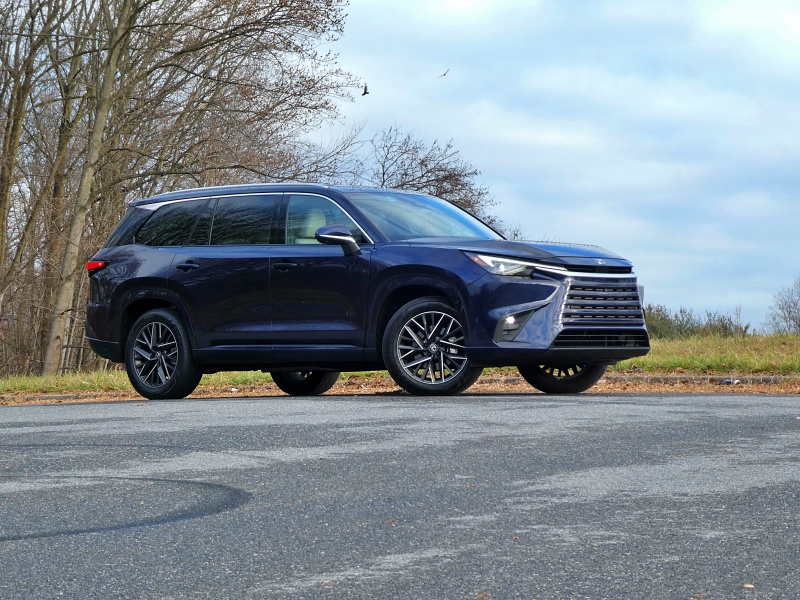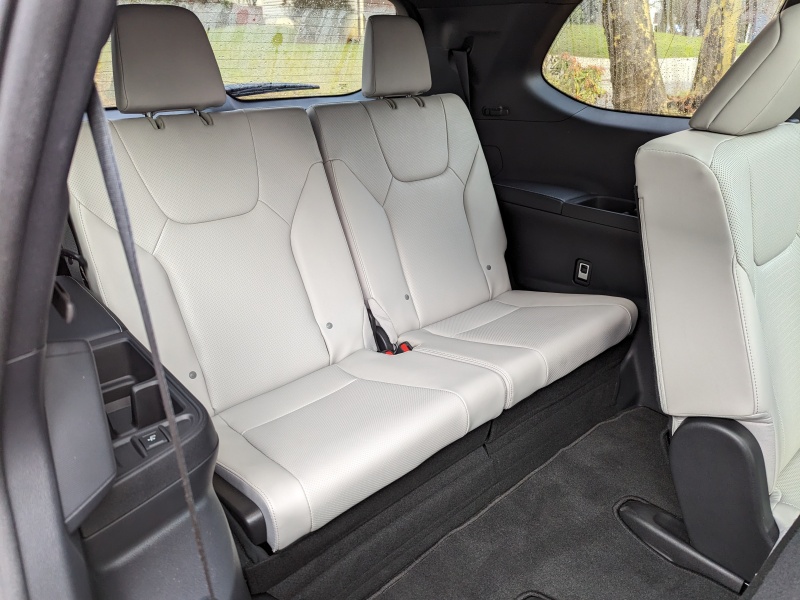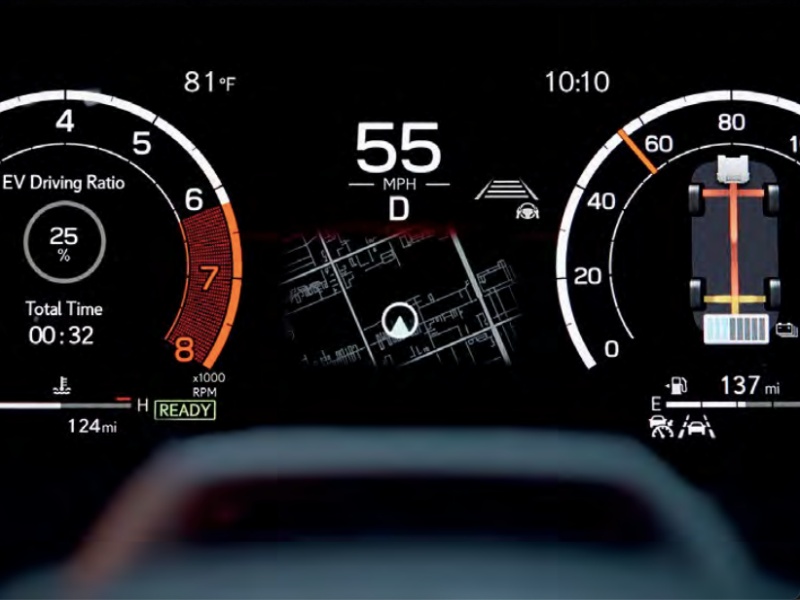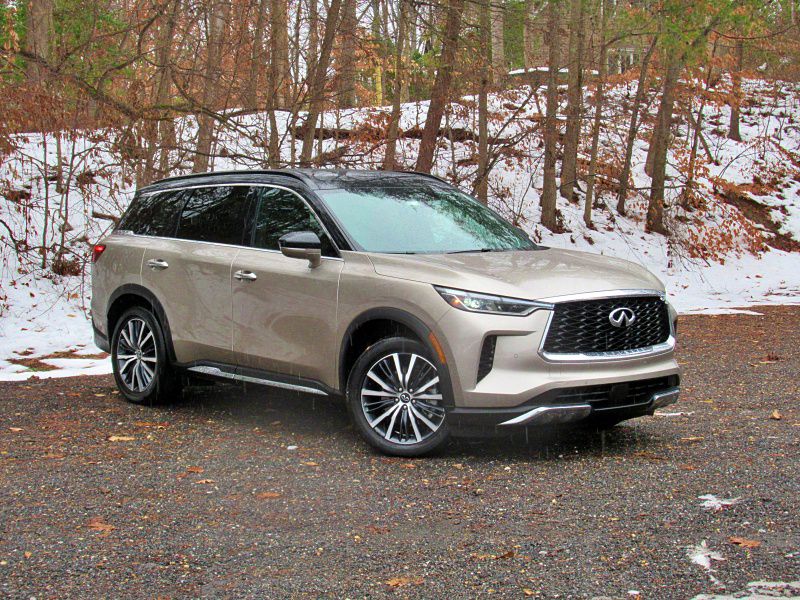Recent Articles
Popular Makes
Body Types
10 Best Features of the 2024 Lexus TX

2024 Lexus TX 350 ・ Photo by Brady Holt
Lexus has sold three-row luxury SUVs since 1996, years before most rivals entered the segment at all. But these were either truck-based SUVs that emphasized off-road performance over maximum comfort and family-friendliness (the mid-size GX and full-size LX) or were much smaller than the competition (the RX L crossover that barely wedged in a third row).
That changes with the all-new 2024 Lexus TX full-size three-row crossover. Lexus built this SUV to pair the best-selling RX model’s trademark comfort, build quality, and reliability with no-compromise size. We just spent a week testing the Lexus TX 350, priced from $53,700. Here are our 10 favorite things about this new model.
1. Finally, Three Proper Rows of Seats
The point of the TX is to provide the three-row spaciousness that the brand has hitherto lacked, and Lexus delivered. The new TX measures 203 inches long, making it one of the largest luxury crossovers on the market.
We don’t mean that you’ll enjoy limo-like accommodations in the way-back seats. Not so much. But especially if the second-row passengers are willing to give up a few inches of their generous legroom (the seat adjusts fore-aft), the low third row becomes habitable for anyone – worlds ahead of any other three-row Lexus and also more comfortable than most competitors. Heating and ventilation are available for both the first and second rows. The front seats are comfortable and supportive as well, with plenty of room on high, commanding perches. The TX’s “F Sport” trim level includes more heavily bolstered front seats, while other TX’s like ours have flatter chairs; make sure you try out the model you plan to buy. Our only other quibble is that the maximum seating capacity is seven, and it drops to six if you swap the second-row bench seat for second-row captain’s chairs. The Toyota Grand Highlander, a less swanky cousin of the TX, can fit up to eight passengers.

2024 Lexus TX 350 ・ Photo by Brady Holt
2. Lots of Cargo Room, Too
The big TX is also generously sized for cargo, too. There’s 20.2 cubic feet behind the third-row seat, 57.4 cubic feet behind the second row, and a whopping 97 cubic feet behind the front seats. That’s more room than any of its closest competitors, including the Acura MDX, Cadillac XT6, Infiniti QX60, Lincoln Aviator, Volvo XC90, BMW X7, or Mercedes-Benz GLS. Only the less opulent Buick Enclave edges out the TX’s cargo volume. We wish the Lexus’s second-row seats were easier to fold – you have to pull two different handles at just the right time – but we appreciate the flat, regularly shaped cargo floor that results.
The TX can also tow 5,000 pounds with any of its three available powertrains, which we’ll discuss in a moment.

2024 Lexus TX 350 ・ Photo by Brady Holt
3. Peppy and Economical Turbo Engine
The most affordable 2024 Lexus TX is the TX 350 like our test vehicle. This model comes with a 2.4-liter turbocharged four-cylinder engine that makes 275 horsepower and 317 lb-ft of torque.
This engine is peppy and quiet. Lexus quotes a 0-60 run of 8 seconds, which is sluggish for a luxury car, but it felt quicker to us in everyday driving. Just don’t plan on thrills with the TX 350. The tradeoff is excellent gas mileage for a big luxury SUV. The EPA estimates it will achieve 21 mpg in the city, 27 mpg on the highway, and 23 mpg combined with front-wheel drive and about 1 mpg less with all-wheel drive, with 91-octane premium fuel required. Our AWD TX 350 averaged 24 mpg during a weeklong test. But as we’ll explain, there’s a way to get even better mileage out of this Lexus – and more power, too.

2024 Lexus TX 350 ・ Photo by Brady Holt
4. Faster Yet More Efficient Hybrid
In addition to its gasoline-only turbo engine, the TX is available with a choice of two hybrid options. The first is called the TX 500h. It essentially pairs this turbo engine with electric motors to boost output to 366 horsepower, cutting the 0-60 time to 6.1 seconds.
Plus, the EPA estimates the TX 500h will get 27 mpg in the city and 28 mpg on the highway. That means you get fuel-sipping mileage when you’re stuck in traffic yet plenty of power when the road opens up. The TX 500h starts at $68,000, or about $8,000 more than a comparably (lavishly) equipped TX 350, so it makes the most sense for someone who values its speed as well as its efficiency – this isn’t a dollars-and-cents hybrid you buy to save money. It’s sold exclusively in F Sport guise with more heavily bolstered sport seats and a firmer, sport-tuned suspension. You can also get it only with second-row captain’s chairs that limit its seating capacity to six.

2024 Lexus TX 500h ・ Photo by Lexus
5. A Plug-In Option
The other TX hybrid is the TX 550h+. This one is a plug-in hybrid, meaning you can charge its battery using electricity from the grid to get 33 miles of gas-free range. Once that range is used up, it gets 28 mpg in the city and 29 mpg on the highway. If you have a fairly short commute and a place to recharge overnight, you might be able to go for days without burning gasoline, yet you can still refuel at any gas station on a long trip.
The TX 550h+ pairs a 3.5-liter V6 with electric motors for a total output of 301 hp, and it reaches 60 mph in 5.9 seconds. These powertrains also require premium fuel. The TX 550h+ has even more standard features and costs about $5,500 more than the equivalent TX 500h (a base price of $78,050). Once again, it’s sold only with six seats, though not as an F Sport model.

2024 Lexus TX 550h+ ・ Photo by Lexus
6. Smooth Ride and Easy Handling
Our TX 350 test vehicle had a blissfully smooth ride in a world where many luxury SUVs either try to be sports cars or off-road bruisers. The Lexus feels lighter than the classic vault-like experience of a BMW or Mercedes, but it’s cushy and quiet on our test vehicle’s standard 20-inch wheels. The 22-inch wheels that are optional on the TX 350 and standard on TX hybrids may be stiffer, especially because every TX 550h is the performance-themed F Sport.
Fortunately, even our TX 350 handled well for a big crossover SUV. It’s not overtly sporty like a BMW X7 or Acura MDX, but it’s composed and feels natural. It’s easy to drive and never felt clumsy even as we sped along back roads. You just wouldn’t choose it for canyon-carving. We haven’t tried out the F Sport, but haven’t found the effects transformative in other Lexuses we’ve tested. We think some customers will wish they could pair the TX 550h hybrid engine with the standard wheels, suspension, and seats, while others might wish for an F Sport variant of the TX 350 or TX 550h+.

2024 Lexus TX 350 ・ Photo by Brady Holt
7. Upscale Yet Intelligent Interior Decor
The TX’s dashboard has a common design theme with the smaller Lexus RX. It’s a subtle, largely unadorned dashboard with a big 14-inch touchscreen. You won’t find coatings of wood or metal trim, or extra-dazzling electronic displays. But while we don’t love its helping of shiny black plastic, we appreciate the rich leather trim and nice moving parts. Even the third-row seat gets nice finishes. Lexus also made smart choices for the TX’s family-friendly mission, like sturdy plastic flooring rather than lush carpeting right where you step into the the rear seating area.
The TX’s controls aren’t as simple as they look. The big touchscreen only lets you see one thing at a time (for example, choosing between the radio or navigation system map), and the steering-wheel controls’ multifunction buttons are easy to mix up. But when you want the vibe of simplicity and quality over an overt display of decadence or technological wizardry, the TX delivers.

2024 Lexus TX 350 ・ Photo by Brady Holt
8. Elegantly Restrained Exterior
The TX’s exterior also shows unusual restraint for a modern luxury SUV. It doesn’t look dipped in chrome. It’s not covered in sharp creases. It doesn’t look angry. Instead, it’s a gently rounded version of the boxier-looking Toyota Grand Highlander. There’s still an upright shape with big windows – a functional SUV, not a sporty performance car.
But it also retains signature Lexus cues that keep it upscale, including the big 20- and 22-inch wheels, the slim rear lightbar, and the subtle hint of Lexus’s signature “spindle” grille. We like the way the TX’s headlights spear themselves across the top of the grille, even preferring it to the latest Lexus RX.

2024 Lexus TX 350 ・ Photo by Brady Holt
9. Well-Priced for Its Size
As we mentioned, the TX faces a lot of competitors – many of which start for less than $53,700. However, it’s bigger and more spacious than most of those. It also comes with a long list of standard features that further help justify its price tag.
The base TX 350 already includes the big 20-inch wheels and 14-inch touchscreen along with heated front seats, adaptive cruise control, second-row windowshades, and a wireless smartphone charger. These frequently cost extra on competing luxury SUVs. The next-up TX 350 Premium, $57,100, adds a moonroof, ventilated front seats, and the chance to buy more upgrades, including a 21-speaker Mark Levinson sound system and the ability to use your phone as a key. The TX 350 Luxury, $59,600, swaps leatherette seats for genuine leather. The TX 500h hybrid opens at $68,000 in its own Premium trim level, but with its extra standard features (including all-wheel drive), it’s the equivalent to a TX 350 costing $59,860. The TX 550h+ starts at $78,050 while equivalently equipped to a $72,650 TX 500h or a $68,225 TX 350.

2024 Lexus TX 350 ・ Photo by Brady Holt
10. Stacks Up Well Against the Competition
The TX was going to be a winner unless Lexus blew it, and Lexus didn’t. The 2024 Lexus TX has a few areas that could improve, such as making the desirable hybrid powertrains more widely available across the model lineup; improving the infotainment system; offering an eight-passenger version; and making it easier to fold the second-row seats. But it already stacks up well against the host of competitors we listed earlier.
Versus the Acura MDX (which invented the three-row crossover segment in 2001) and the Infiniti QX60 (a player since 2013), the TX has more space, better gas mileage, and simpler controls. Of the trio, the Acura is the most fun to drive and the Infiniti has the most opulent interior. Both also cost a few thousand dollars less than the TX and earned slightly higher crash-test scores. Another top rival for family-friendly luxury is the ultra-safe, beautifully finished Volvo XC90, which has its own stellar plug-in hybrid option; like most TX competitors, though, it has less space for passengers and cargo. The BMW X7 and Mercedes-Benz GLS are spacious and delightful to drive, but both start above $80,000. The TX does have some disadvantages against its own cousin, the Toyota Grand Highlander – no eight-passenger seating (or seven-seat capacity with captain’s chairs); no option for the Toyota’s least-powerful yet most economical hybrid engine; more complicated controls; and, of course; a higher price. But the Lexus’s genteel styling, upscale interior finishes, extra-hushed cabin, and longer list of features will keep plenty of folks firmly at their Lexus dealer.

2022 Infiniti QX60 ・ Photo by Brady Holt